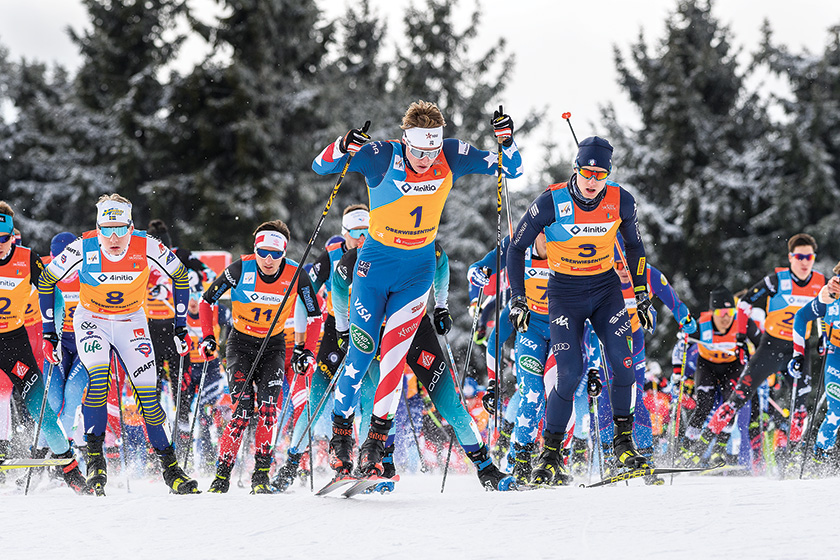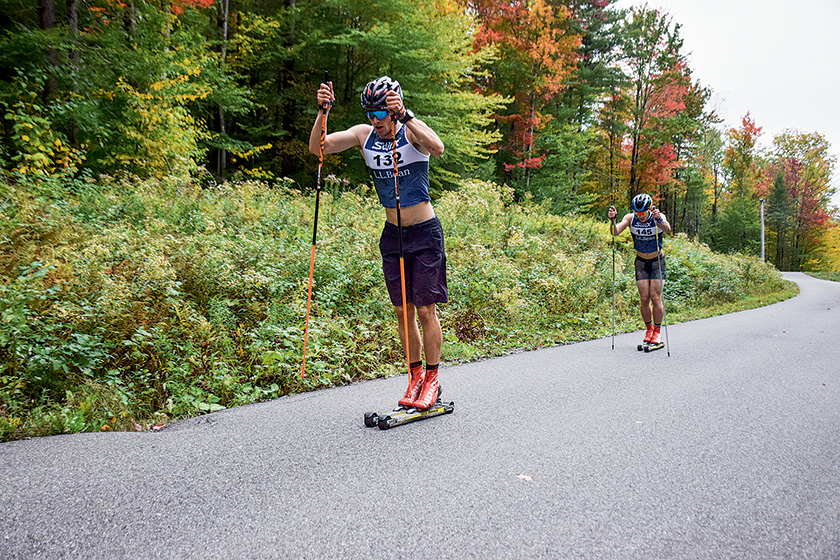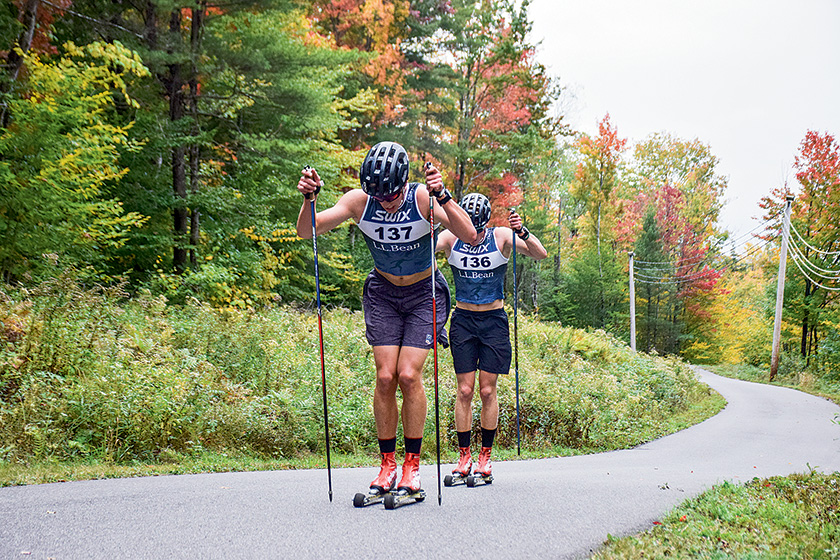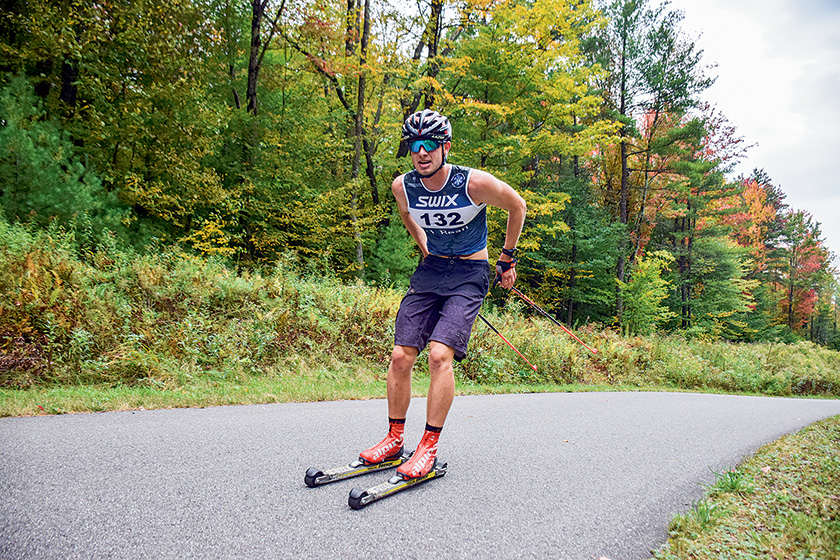The ideal ending to a ski race on television is an all-out, lunge-for-the-line drag race between two athletes—strong legs pumping, carbon poles bending and a camera on rails speeding alongside to capture the final burst of energy as both racers throw a foot forward to get their toe across the line first. It’s riveting drama, and whether the race is freestyle or classic, one thing is common in all these finishes: a whirlwind of ski poles propelling athletes forward at impressive speed. Just how do these skiers generate so much power with such thin shafts of carbon?

The answer lies not just in strong arm muscles but a full-body application of power, a commitment of bodyweight through empty space and a deep understanding of force and propulsion. Put simply, beating a competitor to the line in a double-pole sprint requires more than just triceps and carbon fiber. Let’s break down some critical components of poling with power.
The Posterior Chain
Science and biomechanics aren’t this writer’s forte, but it helps to have some general understanding of the interplay between muscle groups and skeletal structure when it comes to generating power on skis. The posterior chain—the muscles that comprise your backside from head to toe—play a huge role in poling power. Many of us probably envision power coming from two simple sources: the triceps and the abs. While these muscle groups are powerhouses, they alone cannot bear the full exertion from double poling. If you think of your body as a vehicle, your triceps are the steering wheel and your abdominals are the wheels: They serve a clear purpose, and it’s easy to see their work in action, whether you’re watching a car drive or a skier double poling.
Other key muscles are also at work in less obvious ways. The latissimus dorsi is the largest muscle on your back and is responsible for a lot of the contraction and extension that propels your tempo and carries power through your body while double poling. Your rotator cuffs help maintain a stable position in the shoulders and guide both the follow-through of the arms as well as their return to the starting position of the next pole plant. And like so much in skiing, the hip muscles work to keep the thoracic spine stable, the lower back neutral and the lower core engaged.
It’s impossible to overlook the role of the lower body as well, both as the component that reacts to force input and as a power generator when the body returns to the start of the poling motion. Glutes and hamstrings engage when the poles come onto the snow and help maintain stability throughout the push of the poles. These same muscles provide power and propulsion as the poles come up, whether in a subtle motion on flatter terrain or an explosive motion during a sprint finish. The motion of double poling truly involves the entire body working in harmony.
There are a variety of exercises that work the posterior chain, whether involving bodyweight in nature or utilizing gym equipment and free weights. Common gym exercises like squats and deadlifts were long thought inappropriate for skiers, because they did not appear to directly benefit movements seen in skiing. The full-body nature of skiing, however, means that these exercises can play a pivotal role in safe and effective body function. Always seek out proper guidance and help from experts when learning weighted exercises and, in addition to using a SkiErg, know that other classic exercises like planks, dips and pullups can have great benefits on poling power when done effectively.
The Movement Patterns
Depending on terrain and snow type, double poling is not simply the same motion repeated ad nauseum. The frequency, the reach of the arms both fore and aft and the relationship of the hips to the hands changes quite a bit depending on where you happen to be skiing.
On flat and fast terrain, pole tips should hit the snow in front of the ski binding, in a mostly vertical alignment. Your spine should be in a neutral position, with elbows bent at 90 degrees. Gone are the days of reaching out your arms like you are about to give a hug. Instead, relax and bend your knees slightly, with your waist and torso trending forward to gain the reach for which that hugging motion formerly accounted.

As the poles come down, collapse your knees a bit while firing your abdominals and hip muscles to maintain stability in the spine. Apply power throughout the poling motion on flatter terrain; rather than tapping or stabbing the snow, use the length of the poles to cycle through a full range of motion.
The return to the starting position is important. Here, your hips should come up just ahead of your hands coming up. This is due to the longer follow-through of your hands, which on flat and fast terrain may end up behind the waist. When your hands come up, bring them to eye level as the pole tips swing out front of the bindings to begin the process again.

On steeper terrain, the poling process is similar. A key difference is the position of the pole tips, which should be planted closer to the feet or even behind them on very steep terrain. This is because of the fast turnover needed: The poles hit the ground already at an angle and with a greater frequency. In this case, the application of power may seem more like the tap or stab that should be avoided on flat terrain. On steeps, combine the tap with a high tempo and short movements to keep the body moving upward—the skier simply doesn’t have the time or momentum to complete a full range of motion. What’s more, your hands should not push back quite as far and may not even reach to your waist. When returning to the starting position, bring hips and hands up at the same time to keep momentum up and forward.
A sprint-finish double pole with maximum power is a hybrid of these two variations. Bring your hands up with your hips to maximize turnover and forward lean, and put forth strong power in the extension of your legs, which will give even more loft. Newer skiers commonly mistake this motion as standing up on their toes, but the heels instead come up as a factor of the massive momentum swinging upward through the whole body and aided by the legs—picture a wire attached to a performer’s hips in a theater show, dynamically lifting the subject’s body upward and forward.

The follow-through while sprinting is longer than on a steep climb, because with high velocity comes lots of momentum. The tips of the poles reach forward farther than with any other poling variation, because the rest of your body is already being carried forward and upward with great force. If you’re in this situation, you’re likely driving headlong for the finish. Just don’t forget to throw out your toe and lunge for the line.
This story first appeared in the Early Winter 2021 issue of Cross Country Skier (#40.2).
